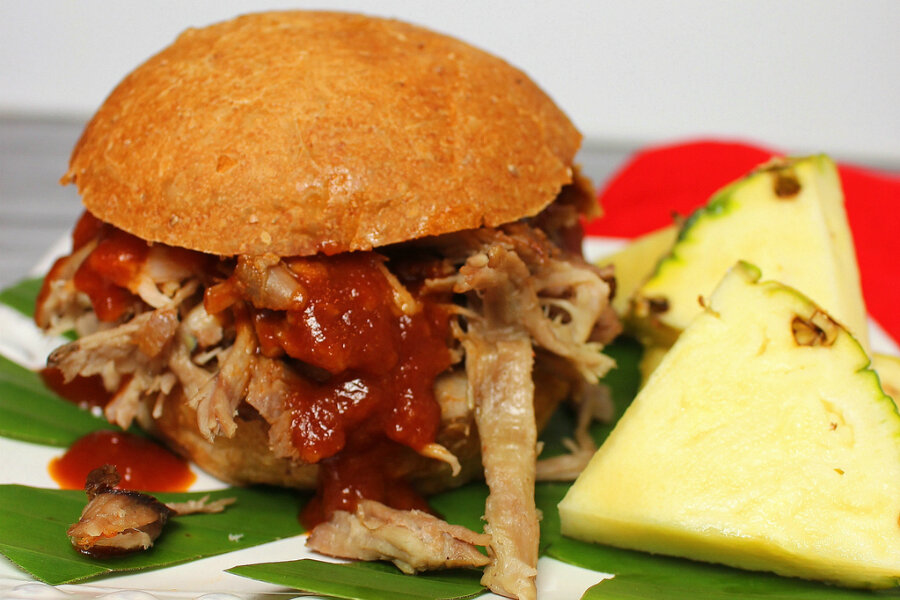Hawaiian pulled pork
I wanted to try Kalua Pig, a Hawaiian style pork recipe usually roasted in an open pit (Also called a “lua”) (from "kalua," to cook in a pit). So if you were wondering, this roast pork dish has nothing to do with kahlua at all, which is a coffee flavored liqueur. And in fact, "lua" forms part of the more commonly known word “luau” which we all know as the fabulous shindig of barbecues that Hawaiians specialize.
Traditionally, these pits are dug into the ground and lined with heated volcanic rocks and pork (sometimes whole suckling pig, but for home use we chose to do a pork roast Boston butt). The pork is wrapped in banana and taro leaves and other island vegetation and roasted at a slow temperature for a very long time.
The pork itself is simply seasoned with a type of coarse Hawaiian pink salt called alaea. You can find that at specialty stores or buy it online. It has a complex flavor and is not quite as salty as other salt types, so it can’t be substituted for on an equal basis (cut back on normal coarse salt).
I cooked this pork roast in an electric smoker with burning wood chips, If you can find them, I have seen orange smoking chips available, but you may be limited on choice. Choose fruity ones over types such as mesquite or hickory. I also used fresh banana leaves (you might be able to find those frozen as well) tied with twine (I had nothing else, but it worked well). If you can’t find banana leaves at all, you can use foil by itself or baste the meat with a mop of pineapple juice, but some of the flavor won’t be there, since the banana does impart that. I did see a recipe for kalua pork somewhere that asked users to supplement with a banana (the fruit). I don’t recommend that. The bananas don’t taste like banana leaves and it isn’t why the leaves are used anyway. They are there to keep the meat moist.
After the pork is cooked and has time to rest and cool down somewhat, the fat is trimmed away and the meat is shredded as you would any type of pulled pork. You can do this with your fingers, shred it with two forks, or chop it with meat cleavers.
I have mixed up a tempting Hawaiian style barbecue sauce to go with my pork, and it is delicious spooned over the meat on a warm bun. You can even add a little coleslaw to your sandwich if you prefer. I like mine without slaw, but sometimes serve it on the side. Hawaiian baked beans also make a good side dish. In my case I served it with pineapple chunks and home made poi (mashed taro root) which I made in a nontraditional style with flavorings I felt improved that side dish greatly.
Hawaiian pulled pork or Kalua Pig
Serves 4 to 6
1 (5-pound) pork shoulder Boston butt roast
3 fresh banana leaves (or if frozen, thawed)
2 tablespoons coarse Pink Hawaiian Alaea salt
1 tablespoon cracked black pepper
kitchen twine
aluminum foil
Other optional ingredients:
Hawaiian style barbecue sauce (see recipe below)
sandwich buns
cole slaw (may I recommend poppyseed slaw?)
orange or other fruit flavored smoking chips
1. Allow roast to come to room temperature.
2. Rub roast on all sides with a mixture of alaea pink salt and cracked black pepper.
3. Wrap roast in banana leaves and secure with twine.
4. Wrap banana leaf-wrapped roast in foil and puncture with a fork all over to make many vent holes (this keeps the banana leaves from drying out and burning).
5. Roast at 275 degrees F. in a smoker, oven, or grill with indirect heat until temperature reaches 185 degrees F., and allow meat to rest and the internal temperature rise to 190 degrees F.
6. When meat is cool enough to handle, trim fat and shred meat.
7. Serve meat on buns with Hawaiian style bbq sauce, if desired.
Hawaiian style barbecue sauce
Makes 1 cup
8 ounces tomato sauce
6 ounces pineapple juice
1/4 cup brown sugar
1 teaspoon minced garlic
1 teaspoon grated ginger root
1 tablespoon Aloha brand Hawaiian soy sauce or dark sweet soy sauce
1 tablespoon apple cider vinegar
2 teaspoons liquid smoke (hickory)
1 teaspoon onion powder
1 teaspoon toasted sesame oil
2 teaspoons Sriracha chili sauce (optional)
Note: Hawaiian brands of soy sauce are generally sweeter; use Hawaiian or dark sweet soy sauce or supplement ordinary soy sauce or tamari with a little brown sugar to taste)
Mix together ingredients in a saucepan and simmer over low heat until mixture reduces to one cup, about 20-25 minutes total.
Related post on A Palatable Pastime: Hawaiian macaroni salad







